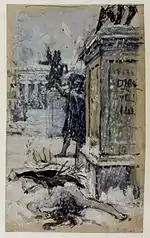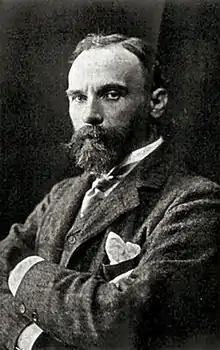| Saint Eulalia | |
|---|---|
 | |
| Artist | John William Waterhouse |
| Year | 1885 |
| Medium | oil on canvas |
| Dimensions | 188.6 cm × 117.5 cm (74.3 in × 46.3 in) |
| Location | Tate Britain, London |
Saint Eulalia is an oil painting on canvas in the Pre-Raphaelite style, created in 1885 by English artist John William Waterhouse, depicting the aftermath of the death of Eulalia of Mérida. It is currently housed at Tate Britain.
History
A very daring composition, this is one of Waterhouse's most unusual, and consequently most striking, oil paintings. The corpse is dramatically foreshortened, and the snow contrasts with that of Eulalia's naked flesh – the 12-year-old girl seems singularly out of place for a Waterhouse picture.[1] His choice of configuration – situating the corpse across the front and leaving so much of the central canvas unoccupied – was risky but it worked: by placing all the background figures in the distance, he concentrated the viewer's gaze on the naked body.[2] The nudity was also groundbreaking for Waterhouse – and something that could have laid him open to criticism – but his sensitive handling of the subject, the youth of the saint, and the historical context of the painting allowed him to escape the critics' pen.[3] The eye is also led to the murdered girl by the angle of the Roman guard's spear, pointing to the ropes that had bound her to the stake.
According to legend,[4] the snow was believed to have been sent by God as a shroud to cover the saint's nakedness; the dove, seen flying upwards near the crowd of mourners, is indicative of Eulalia's soul rising to Heaven, having flown out of her mouth.[5]
See also
References
- ↑ P. Trippi, J.W. Waterhouse, Phaidon Press (2005), s.v. "St Eulalia".
- ↑ A. Noakes, Waterhouse. John William Waterhouse, Chaucer Press (2004), passim
- ↑ Cf. critique at johnwaterhouse.com.
- ↑ See Wiki entry, "Saint Eulalia of Mérida". Also, she appears in Thieleman J. van Braght, Martyrs Mirror: An account of Those who Suffered in the Fourth Century (1660), see Martyrs Mirror excerpt
- ↑ Quoted by Waterhouse in the exhibition catalogue (see Tate's entry). Cf. also Blackburn and Holford-Strevens: Oxford Book of Days, entry for 10 December.

Further reading
- Dorment, Richard (29 June 2009), "Waterhouse: The modern Pre-Raphaelite, at the Royal Academy – review", The Daily Telegraph.
- Moyle, Franny (13 June 2009), "Pre-Raphaelite art: the paintings that obsessed the Victorians [print version: Sex and death: The paintings that obsessed the Victorians]", The Daily Telegraph (Review), pp. R2–R3.
- Noakes, Aubrey, Waterhouse. John William Waterhouse, Chaucer Press, 2004.
- Simpson, Eileen (17 June 2009), "Pre-Raphaelites for a new generation: Letters, 17 June: Pre-Raphaelite revival", The Daily Telegraph.
- Trippi, Peter, J.W. Waterhouse, Phaidon Press, 2005.
External links
- St Eulalia at Tate
- St Eulalia at JohnWaterhouse.com.
- John William Waterhouse.net
- John William Waterhouse (The Art and Life of JW Waterhouse)
- John William Waterhouse (Comprehensive Painting Gallery)
- John William Waterhouse Style and Technique
- Waterhouse at Tate Britain
- Ten Dreams Galleries
- John William Waterhouse in the "History of Art"
- Butler's Lives of the Saints – Saint Eulalia of Mérida from catholicforum
